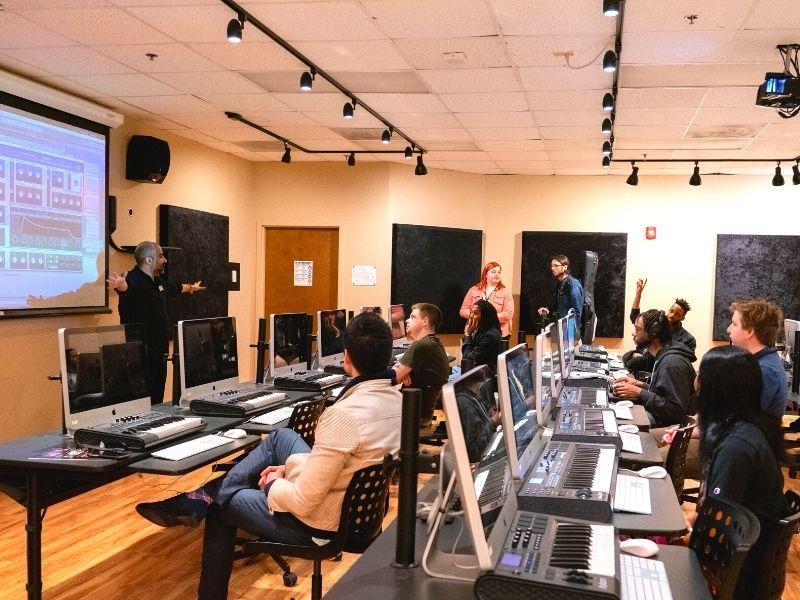Writing a Hit: Pop Song Dynamics and Structure
Key Takeaways:
- Fundamental Structures: Understanding the standard elements of pop song structure—verse, chorus, bridge, and pre-chorus—is crucial. These components form the backbone of successful pop songs, creating a familiar yet engaging musical journey for the listener.
- Creative Variations: While traditional structures provide a foundation, incorporating variations and blending elements from different genres can significantly enhance a song's appeal. Experimenting with chord progressions, rhythms, and instrumental breaks can produce innovative and memorable music.
- Strategic Composition: The effective use of music theory and songwriting skills is essential in crafting hit songs. A strong focus on catchy hooks, memorable choruses, and dynamic bridges can make the difference, ensuring the song resonates with its audience and stands out in the competitive music industry.
Are you dreaming of writing the next successful pop song?
Do you have the chorus melody dancing in your head, ready to be shaped into a hit?
Or maybe you're unsure where to start.
If you're a pop music fan, chances are you're already familiar with its common song structure—you might not realize it yet.
Creating music often involves reusing elements from different sections to maintain a sense of familiarity, though not identical, throughout the song.
This guide will not just repeat what a pre-chorus or bridge entails but also explore the various elements essential in crafting a hit pop song.
Understanding these structures is key whether you're a budding songwriter or an aspiring music producer.
Let's unpack the secrets to structuring your favorite pop songs effectively.
Table Of Contents
- The Intro
- First Verse
- Pre-Chorus
- Chorus
- Rinse and Repeat
- Bridge and Outro
- FAQ: How To Structure A Pop Song
- Getting Started
1. The Intro
The intro sets the stage in pop music, but it doesn't need to be complicated.
It can be a testament to your creativity, a simple musical element that seamlessly transitions into the verse melody.
Many successful songs cleverly extract a fragment from the melodic hook or the chorus melody, embedding it in the intro to give listeners a taste of the song's vibe right from the start.
This technique introduces the song's musical structure and ensures that the intro is immediately recognizable—a crucial factor in catching the attention of fast-paced music listeners.
The choice of instruments can vary from minimalistic arrangements, like a subtle combination of drums and keys, to richer musical backdrops devoid of vocals.
This strategic use of the intro can make a song instantly identifiable.
The first few seconds of a hit pop song's intro will evoke a sense of familiarity and anticipation.
Effective intros create an impactful first impression, a factor that can significantly influence a pop song's popularity on the charts.
2. First Verse
The first verse is your chance to captivate the listener with the vocalist's unique tone and the song's narrative.
Here, the verse acts as a narrative bridge, typically spanning 8-16 bars—each bar measuring a sequence of four beats, like the rhythmic pulse of 1-2-3-4.
This is where the story unfolds, setting the tone and engaging the audience deeply.
In today's music landscape, where new songs flood the market daily, quickly capturing the listener's attention is crucial.
The modern listener's attention span is short.
They often browse songs on their favorite streaming services, searching for that one track that resonates.
It's common for listeners to skip tracks within seconds if not immediately drawn in.
Therefore, making a strong, memorable impact in the first verse is essential.
This initial engagement is vital as it sets the expectation and interest for the rest of the song, determining whether they hit 'Next' or stay tuned for what comes next.
3. Pre-Chorus

The pre-chorus, often simply called the "Pre," bridges the verse and chorus, introducing slight lyrical and musical variations.
While it carries a similar theme to the verse, the pre-chorus sets the stage for a dynamic shift, particularly in pop songs influenced by electronic dance music.
This section is where anticipation builds, marked by the following elements:
- Drums may execute a roll accompanied by a crescendo, gradually increasing in volume and intensity.
- The vocalist might amplify their delivery, singing with increased volume or reaching higher notes.
- Phrases become shorter, creating a sense of urgency and momentum.
- A quick change in chord progression hints at the impending chorus, preparing the listener for the climactic part of the song.
Typically, the pre-chorus spans 4-8 bars, acting as the perfect setup for the chorus, ensuring it hits with full impact.
This strategic musical crafting enhances the song's dynamic flow and primes listeners, heightening their emotional engagement right before the chorus unfolds.
4. Chorus
The chorus, or "Hook," is where the magic of a pop song truly unfolds.
This is the core of the song, where the melody becomes an irresistible earworm, the kind that lingers in the listener's mind long after the song has ended.
The chorus is the most vibrant and memorable part of any track, where the melody needs to be catchy and impactful.
Melody reigns supreme—take your time to craft something that truly resonates.
Typically, a chorus spans 8 bars, providing just enough time to establish the song’s central theme and make it memorable.
This section is not just about catchy tunes; it's about creating a strong emotional connection with the audience, making them feel the energy and emotion of the song.
It's where listeners find that sense of resolution that ties together the musical journey begun in the verses and pre-chorus.
A well-crafted chorus can elevate a song from good to great, transforming it into a hit that people remember and want to replay and share.
It’s the heartbeat of any successful pop song, ensuring that the track stands out in the bustling world of popular music.
5. Rinse and Repeat (With Variation)
After the initial chorus, the structure of pop songs often cycles back to another verse and pre-chorus, but with subtle variations to maintain listener interest.
While keeping the fundamental melody, altering the lyrics or introducing a new lyrical twist in the subsequent verse can refresh the song's appeal.
For instance, dividing your verses into distinct parts, like Verse 1A and Verse 1B, followed by Verse 2A and Verse 2B after the chorus, is a common technique.
Verse 2B might vary in melody and style, providing a delightful contrast to the earlier sections.
It is crucial to incorporate changes in dynamics during these cycles. Adding harmonies or different vocal textures during the pre-chorus can invigorate the song, making these sections stand out.
It’s essential, however, to use these harmonies judiciously—overusing them can dilute their impact.
These modifications keep the song engaging throughout its entire duration and underscore the songwriting process's creativity.
By strategically altering elements like melody, lyrics, and harmonies, you ensure the song remains captivating throughout its runtime.
You'll avoid the pitfall of repetition and maintain the listener's attention.
6. Bridge and Outro
After your second engaging chorus, the bridge introduces a fresh element to your song, pivoting to the final act.
The bridge is a unique section, providing a necessary shift that guides listeners toward the song's conclusion.
Often, songwriters encounter a creative challenge here, as the earlier verses, pre-choruses, and choruses have set high expectations.
This is your chance to add depth and complexity to your composition.
In situations where the song has yet to reach the three-minute mark, the bridge offers an opportunity to extend the musical experience.
Introducing major or minor chords that contrast with those in the previous chorus can create a striking difference, signaling listeners that something new is unfolding.
This contrast enriches the listener's experience by highlighting the transition within the song's structure.
The bridge can lead back into a pre-chorus or dive directly into the final chorus.
The bridge builds tension once more before releasing it in the last chorus, providing the audience with a memorable finale that leaves a lasting impression of enjoyment.
FAQ: How To Structure A Pop Song
1. What is a pre-chorus in pop music?
The pre-chorus is a section that helps to build tension and anticipation before the main chorus. It often introduces a shift in melody or lyrics to prepare listeners for the climax of the song.
2. How do rock songs differ in structure from pop songs?
Rock songs may include more extended instrumental sections, such as guitar solos, and often use a more complex verse-chorus structure compared to the typically catchy and repetitive nature of pop songs.
3. Can you explain the 12-bar blues influence on modern pop music?
The 12-bar blues form, characterized by its repetitive chord pattern, influences many genres, including pop. It provides a familiar structure that can be adapted for a catchy hook, contributing to the song's overall appeal.
4. What are common elements of a hit pop song?
A hit pop song typically includes a memorable hook, a dynamic chorus, and a structure that keeps the listener engaged. Effective use of melody, rhythm, and lyrical content are also crucial.
5. How does music theory apply to pop songwriting?
Music theory provides songwriters with a framework for understanding how melodies, chords, and rhythms work together. This knowledge is essential for crafting harmonious and appealing songs to a broad audience.
6. What role does a music producer play in shaping the structure of a song?
A music producer collaborates with artists to refine their music, often influencing the song's structure, sound, and overall style. They help to ensure the song meets commercial standards and has potential for success in the music industry.
7. How can I incorporate multiple music genres into a pop song?
Blending genres involves mixing elements like rhythm, instrumentation, and style from different musical backgrounds. This can create a unique sound that appeals to a wider audience, enhancing the song's marketability.
8. What is the significance of the bridge in a pop song?
The bridge contrasts the rest of the song, often introducing a new perspective or shifting the mood before returning to the familiar chorus. It's a crucial element for maintaining listener interest.
9. How can experimental and folk music influence pop song structures?
Incorporating elements from experimental and folk music, such as unconventional instruments or storytelling lyrical styles, can add depth and uniqueness to pop songs, distinguishing them in a crowded market.
10. What are some tips for writing a catchy chorus?
A catchy chorus often relies on repetition, simplicity, and emotional resonance. A strong melodic hook and memorable lyrics can make the chorus stand out and easily singable, which is key to popularity.
Getting Started!

Remember, in music, there are no absolute rules.
While guides and established structures are helpful, observing what has worked for successful songs and learning from your musical idols can be invaluable.
Trust your instincts if you're crafting a song and feel the urge to skip an additional verse or pre-chorus before launching into that powerful chorus.
Pop song structures can vary, and what we've discussed is merely a primer to get you started with a basic song structure favored by many songwriters.
If you're aspiring to excel as a musician, you're already making strides by seeking knowledge independently.
However, a remarkable way to distinguish yourself is through formal education at an accredited institution.
Consider the Atlanta Institute of Music and Media, where industry experts lead innovative music and media programs.
The hands-on coursework integrates technical and musical skills, preparing you uniquely for the industry.
Explore more about how AIMM can elevate your musical journey by clicking below.
















